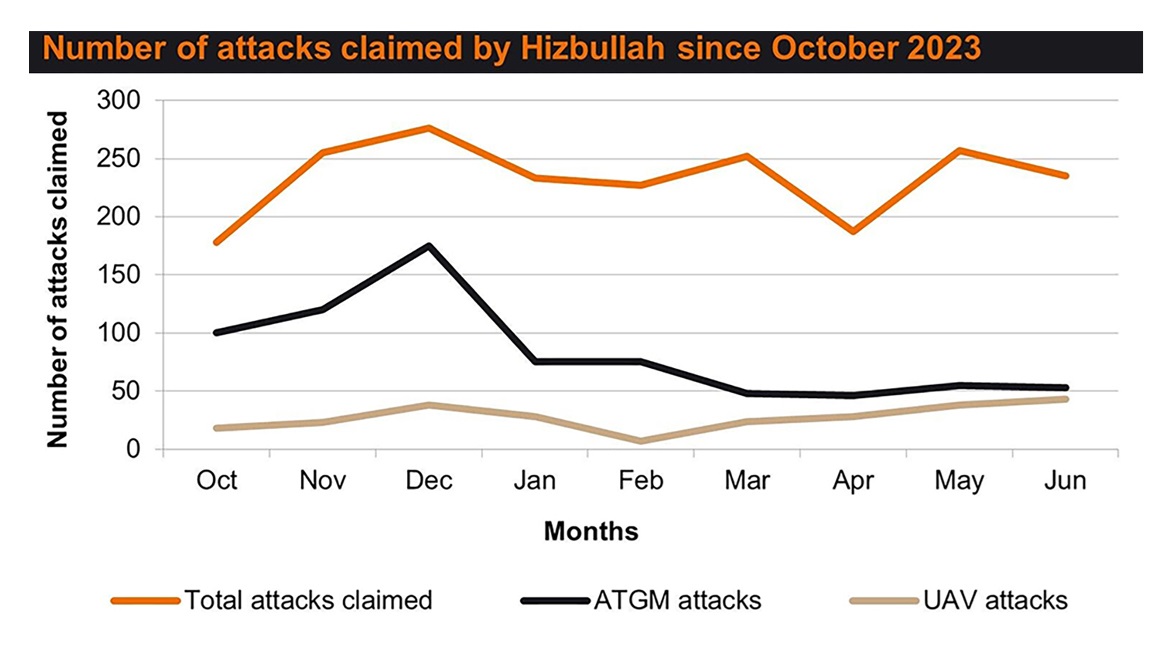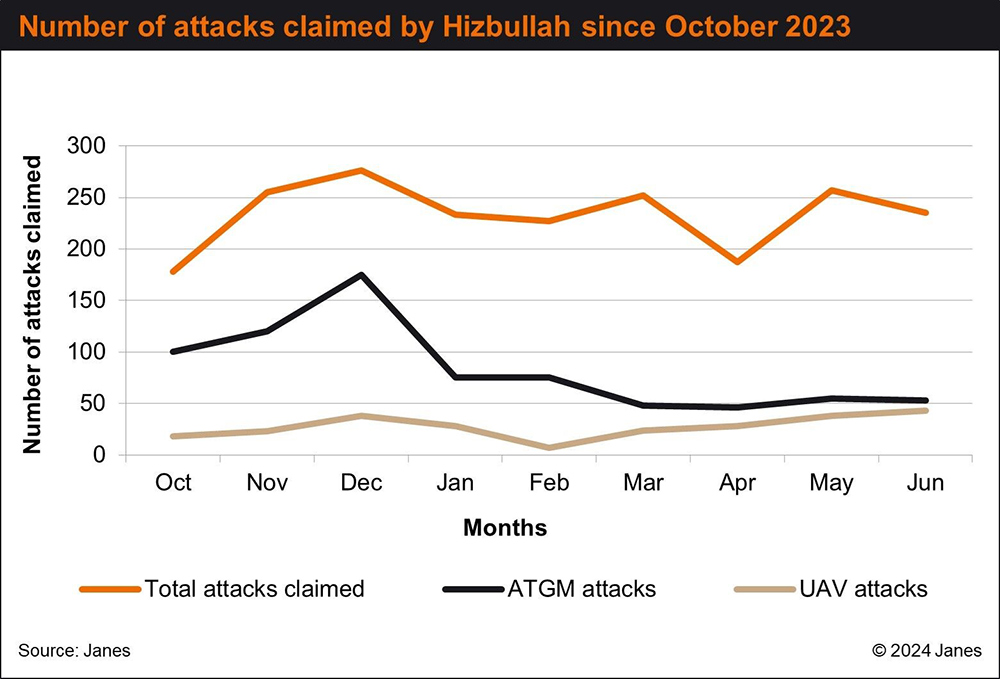
Date Posted: 25-Jul-2024
Author: Suraj Ganesan, Bangalore
Since 8 October 2023 Israel and Hizbullah have been engaged in a low-intensity attritional conflict that was triggered by the Israel-Gaza war. As the conflict continues into its ninth month, Hizbullah remains committed to fixing and attriting the IDF especially in the northern border areas, in support of Hamas in Gaza, raising the risk of an Israeli intervention in southern Lebanon. Suraj Ganesan analyses the military trends and tactics employed by Hizbullah since the start of the Israel-Gaza conflict
Assessments
- Objectives: Hizbullah's stated objectives include fixing and attriting Israeli security forces in northern Israel to alleviate Israeli military pressure against Hamas in Gaza. The militant group also aims to increase political pressure on the Israeli government through prolonged evacuation of civilians from northern Israel. Since the start of the conflict, the group appears to have been successful in these objectives and is very likely to maintain these objectives in the short to medium term
- Attack trends: Since October 2023 Hizbullah has maintained the intensity of its attacks against Israeli security forces, claiming an average of at least 249 attacks per month. It has done so by employing a variety of precision and unguided munitions to target civilians and Israeli security forces, including headquarters and military bases
- From October to December 2023 the militant group relied on anti-tank guided missiles (ATGMs) to achieve tactical gains against Israeli forces with minimal collateral damage. Since February Hizbullah has increased its reliance on unmanned aerial vehicles (UAVs) to strike deeper into Israel, attacking strategic targets
- Janes assesses that it is almost certain that Hizbullah will use its large stockpile of rockets and missiles in the event of the conflict escalating to an Israeli incursion into southern Lebanon. This would include a variety of longer-range missiles and rockets that Hizbullah has not yet deployed in the conflict so far
- Indicators: Hizbullah is very likely to continue its attacks against Israeli forces in the immediate to short term. In addition, the dynamics of the conflict indicate that both sides prefer a diplomatic solution. However, the potential for uncontrolled escalation continues, thereby posing a significant risk of an all-out war. Janes assesses the most likely uncontrolled escalation would be triggered by Israeli assassinations of high-value Hizbullah personnel or a major attack by Hizbullah's precision weapons targeting critical Israeli assets inside Israel
Context
Since initiating the conflict on 8 October, Hizbullah and allied militant groups in Lebanon such as Hamas, Jama'a al-Islamiyya, and the Lebanese Resistance Brigades have claimed to have conducted at least 2,243 attacks against Israeli targets as of 17 July. These attacks have resulted in the deaths of at least 18 Israeli soldiers and 12 Israeli civilians. On 16 June the Israel Defense Forces (IDF) claimed that these attacks included the launching of over 5,000 rockets, missiles, and UAVs. During the nine-month conflict, Hizbullah's tactics have gradually shifted from close-range attacks against Israel's border posts and settlements using rockets and ATGMs to deeper and more precise UAV strikes on Israeli military infrastructure.
The implications of these shifting tactics are that Hizbullah is gradually learning to overcome Israeli air defences that have historically been robust. Notably, on 18 June and 9 July Hizbullah released footage of sensitive Israeli military sites, likely taken by a small UAV belonging to the group, demonstrating Hizbullah's ability to penetrate Israeli air defences of strategic locations. In addition, Israeli forces and the country itself will very likely face a far greater threat from Hizbullah's large stock of missiles, rockets, and UAVs in the event of an Israeli incursion into southern Lebanon.
In response to Hizbullah's attacks, Israel has been conducting precise retaliatory strikes on Hizbullah militants' positions, ranging from artillery bombardment and airstrikes against sources of fire to precise airstrikes against high-value targets such as senior Hizbullah officers and weapons-storage facilities. Israeli operations have resulted in the deaths of at least 360 Hizbullah militants since October 2023.
Hizbullah's attacks, while very likely seeking to avoid an uncontrolled escalatory dynamic with Israel, have also established an operational precedent that can be repeated during periods of heightened tensions. The actions of Hizbullah since 8 October have demonstrated that the IDF has lost its broad-based deterrence against the group, which will very likely require Israel to augment its strategic disposition in the north of the country.
For analyses on the scenarios that Israel could pursue to establish greater security along its northern border, please see Scenario analysis: Israel's options for restoring deterrence against Hizbullah in southern Lebanon .
Methodology
Since October 2023 Janes has observed that Hizbullah has largely provided accurate details on the number and types of its military operations against Israel. One notable exception is the use of UAVs, which Hizbullah will frequently not report and are instead reported by Israeli media.
Also, while largely accurate, Hizbullah's claims of attacks have included exaggerated statistics regarding Israeli security forces and civilian casualties, and the damage caused by these attacks.
This report has reviewed claimed attacks by Hizbullah from the group's media channels on encrypted social media platforms such as Telegram as well as the group's affiliated media channels such as Al-Manar and Al-Mayadeen to provide insights into its trends and tactics.
Generally, these claims from Hizbullah indicate the occurrence of an attack rather than the number of weapons employed in each attack. For example, on 27 December 2023 Hizbullah fired at least 30 rockets towards Kiryat Shmona in Israel's Northern District in retaliation to an Israeli airstrike that killed three civilians in southern Lebanon. Hizbullah claimed this as a single attack rather than 30 attacks.
In addition, much of the data has also been corroborated through IDF statements and local Israeli and Lebanese online news platforms.
Hizbullah objectives
Since the start of the conflict, Hizbullah's stated objectives have been to:
- Fix and attrit Israeli forces in the north of the country to slow Israel's military progress in the Gaza Strip, locking the two sides into a low-level conflict
- Exert political pressure on the Israeli government through the prolonged evacuation of the northern areas
Janes assesses that these stated objectives have largely dictated Hizbullah's operational activities along the Lebanon-Israel border. Within these stated objectives, Janes further assesses that Hizbullah has sought to establish a proportional response dynamic with Israel to control escalation.
Indeed, secretary-general of Hizbullah Hassan Nasrallah has continually stated in his speeches since October 2023 that “Hizbullah would escalate if Israel escalated”. This strategy is frequently reflected in the group's attack statements, which often claim attacks as retaliation to Israel's operations in Gaza and Lebanon. Consequently, when Israel has expanded its operations, often by targeting senior militants, Hizbullah has subsequently responded with a significant attack of its own.
Hizbullah attack trends since 8 October 2023
Since the start of the conflict, Hizbullah has conducted its attacks with a regular cadence averaging 7–8 attacks per week. However, the weekly average of claimed attacks rose to over 10 attacks from 21 May to 12 June, eventually tapering down to about 5–6 attack claims post-12 June, marking the lowest average in attack claims by Hizbullah since the start of the conflict. The last few weeks of May and early June witnessed an increase in Israeli rhetoric regarding a possible incursion into southern Lebanon. It is likely that Hizbullah sought to demonstrate its commitment to supporting Hamas in the face of Israeli bellicose rhetoric, and to demonstrate its readiness for a wider conflict, likely explaining the increase in the weekly average of attack claims in that period.
Hizbullah claimed 276 attacks in December 2023, the highest number of attacks claimed by the militant group in a single month since October 2023, followed by November when the group claimed 255 attacks. On 24 November Israel and Hamas announced a four-day truce, which was further extended by three days, totalling seven days of pause in fighting between the two sides. While Hizbullah was not officially involved in the truce, the militant group observed a pause in clashes with Israeli forces, expressing solidarity with Hamas. Israeli forces announced that fighting resumed on 30 November, while Hamas and Hizbullah followed suit. Janes assesses that the brief ceasefire from 24 to 30 November very likely allowed Hizbullah to prepare for another round of combat resulting in an increase in attack claims in December.
April witnessed the lowest number of claims with 187 attacks. This reduction in attack coincided with the withdrawal of the IDF's 98th Division from Khan Younis in Gaza. The IDF announced on 8 April that the 98th Division “concluded its mission” in Khan Younis and was leaving the Gaza Strip to “recuperate and prepare for future operations”.
 The graph shows the total number of attacks claimed by Hizbullah since October 2023 and the number of ATGM and UAV attacks, corroborated by Janes through local Israeli and Lebanese media. (Janes)
The graph shows the total number of attacks claimed by Hizbullah since October 2023 and the number of ATGM and UAV attacks, corroborated by Janes through local Israeli and Lebanese media. (Janes)


